-
An atmosphere in radiative-convective equilibrium cannot be stationary.
It must be in constant motion to maintain the equilibrium structure.
This is the RDC.
Its flow is not forced by dynamics, but is built into the mean field of the atmosphere.
https://www.rdctheory.cloud/current/RDCParam.html - Without the RDC, the tropospheric atmosphere would settle into radiative equilibrium, the most natural state for a stationary atmosphere.
-
However, it is a mistake to try to force a stationary atmosphere to be convection-driven.
This is exactly what DD tries to do:
it creates an unnatural forced state instead of a natural equilibrium state with RDC.
https://www.rdctheory.cloud/current/whatIsWrong.html
RDC mechanism is summarized in the thread to this tweet. Just trace the thread for a quick overview. Note that we consider time-mean components of physical values in the atmosphere.
https://www.rdctheory.cloud/current/RDCParam.html
-
Cumulus is a domain of small horizontal cross section
where vertical mixing of the atmosphere occurs.
There is no dynamical mechanism in cumulus convection itself
to transport mass/heat/water vapor horizontally from the interior
to the exterior as assumed by DD.
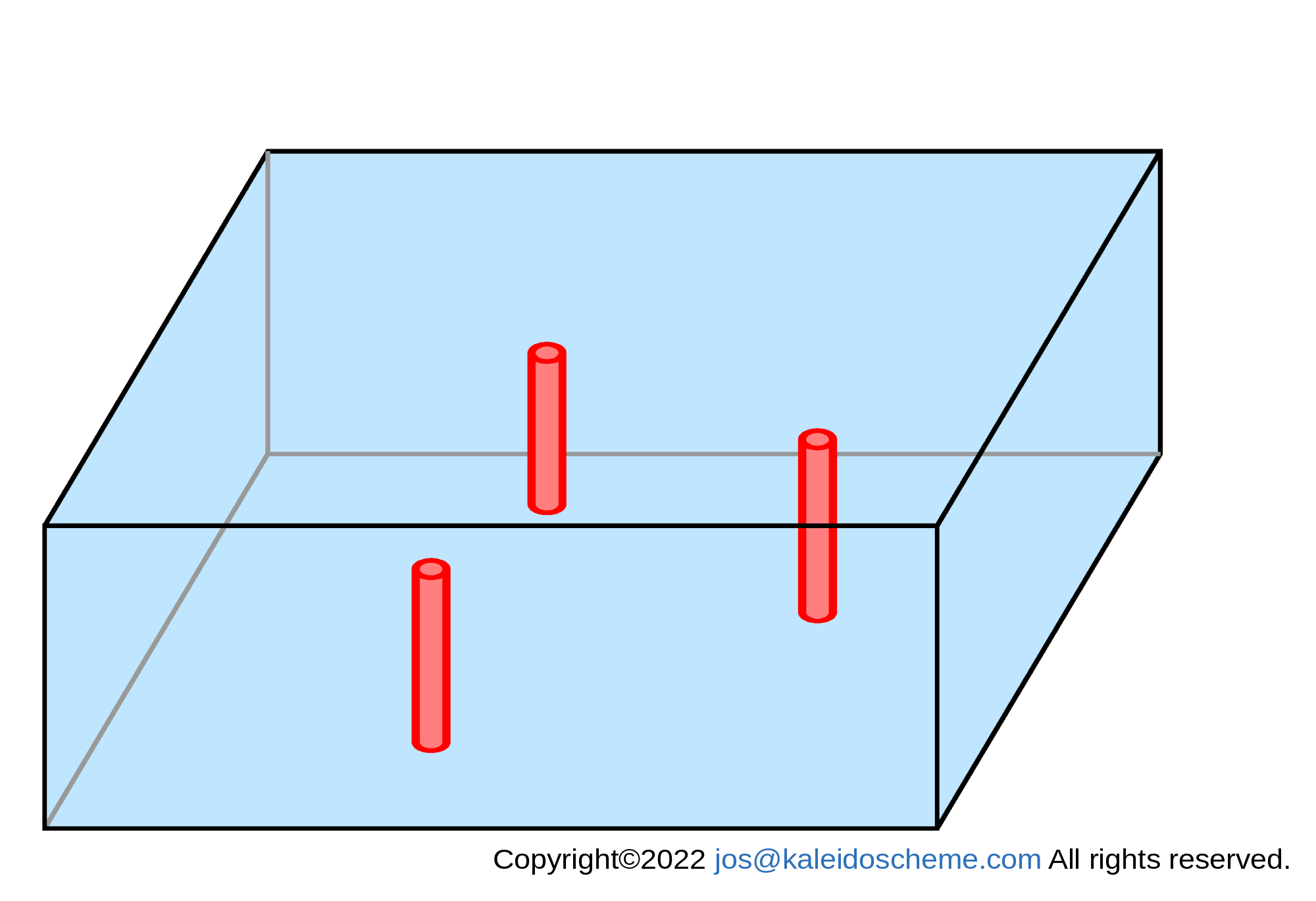
-
Radiative cooling occurs constantly throughout the troposphere,
which is maintained in a state of radiative-convective equilibrium
that is different from the radiative equilibrium state.
There is no need for forcing from cumulus clouds here.
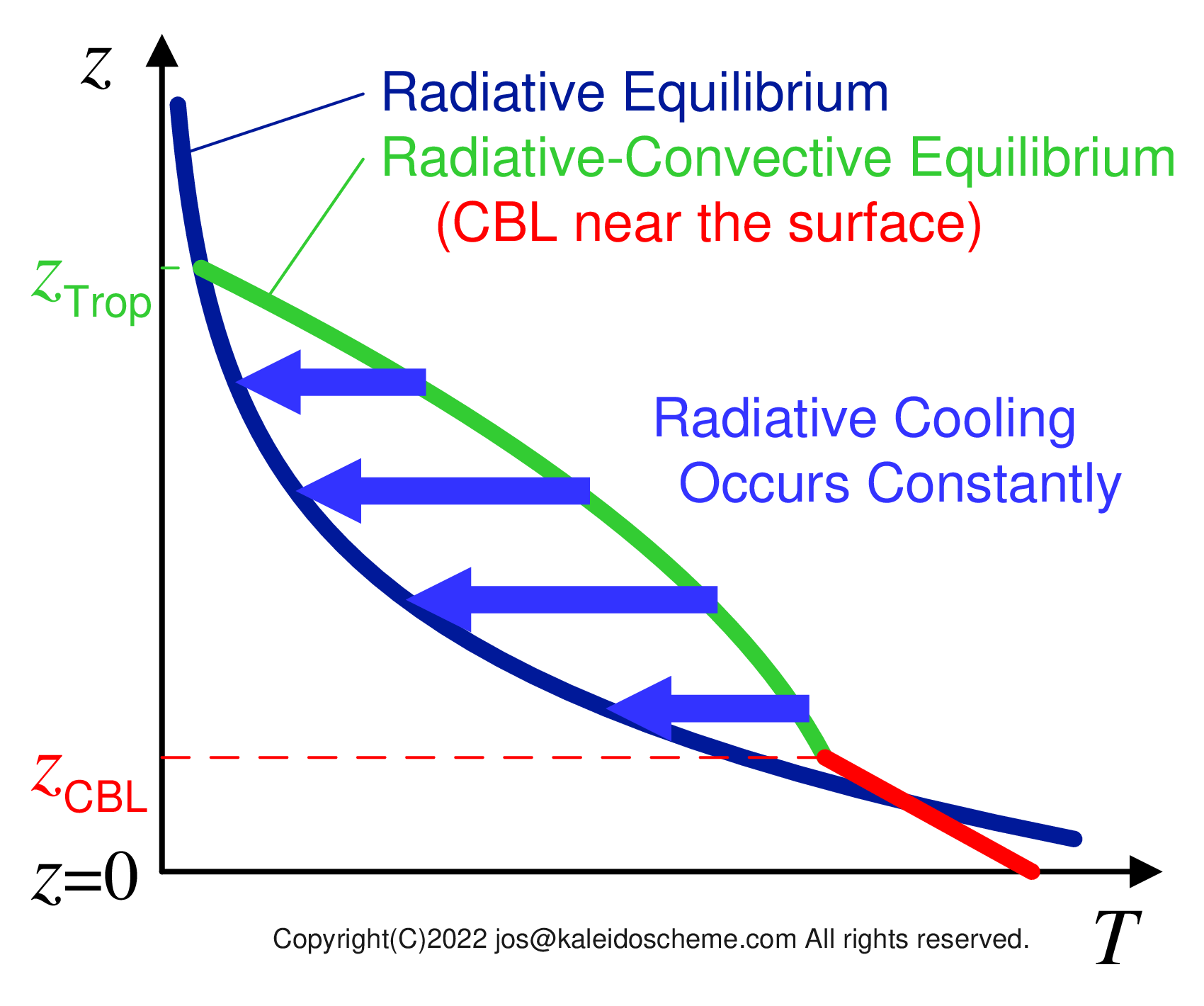
-
The air parcel outside the cumulus clouds subsides at an equilibrium velocity wR
along the ambient temperature,
restricted by a restoring force of positive/negative buoyancy,
which makes the air parcel unforced and the ambient atmosphere undisturbed thermally.

-
Due to the fairly homogeneous equilibrium subsidence velocity wR
and steeply stratified density ρ,
the field of subsidence mass flux ρwR alone is mass divergent,
which would create a vacuum everywhere in the ambient atmosphere.
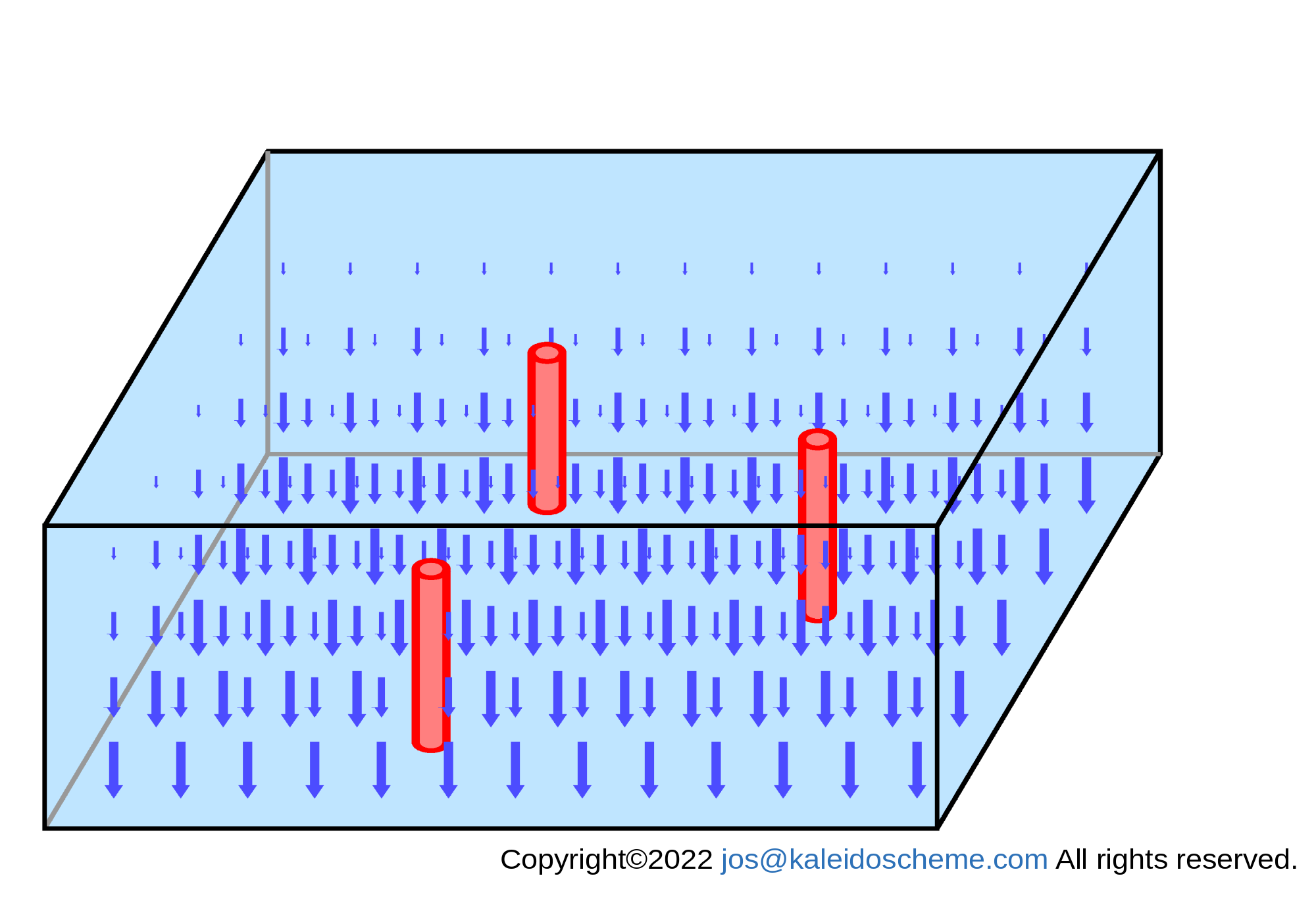
-
To compensate for this vacuum,
a horizontal mass flux (ρuR, ρvR) is induced
from the cumulus domain into the surrounding atmosphere.
This is solved not as a dynamics problem,
but as a boundary value problem to maintain mass continuity.
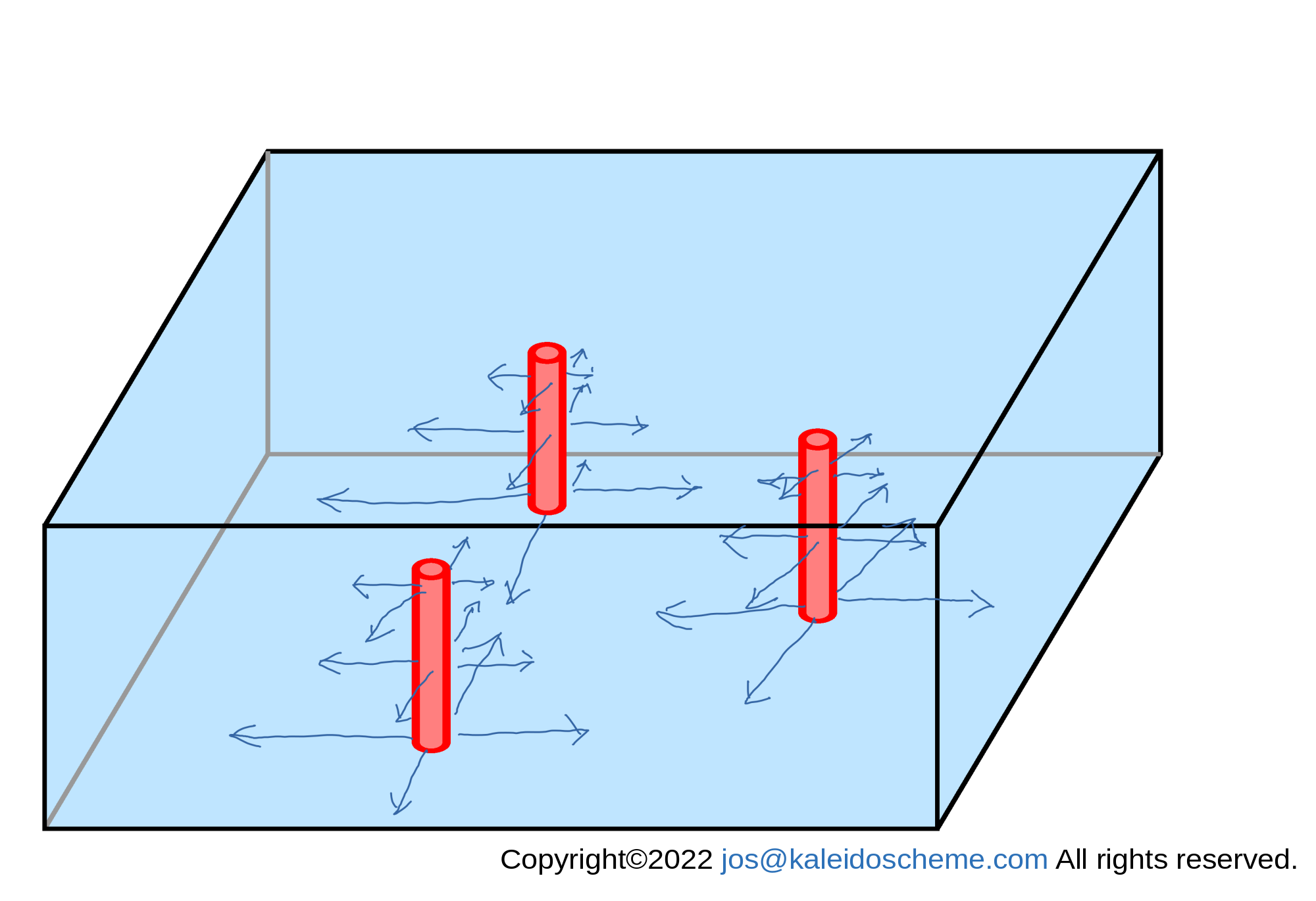
-
The equilibrium subsidence mass flux ρwR
and the compensating horizontal mass flux (ρuR, ρvR)
constitute the flow field of the Radiatively-Driven Circulation (RDC).
It is created by the structure of the radiative-convective equilibrium atmosphere
with a large physical scale.
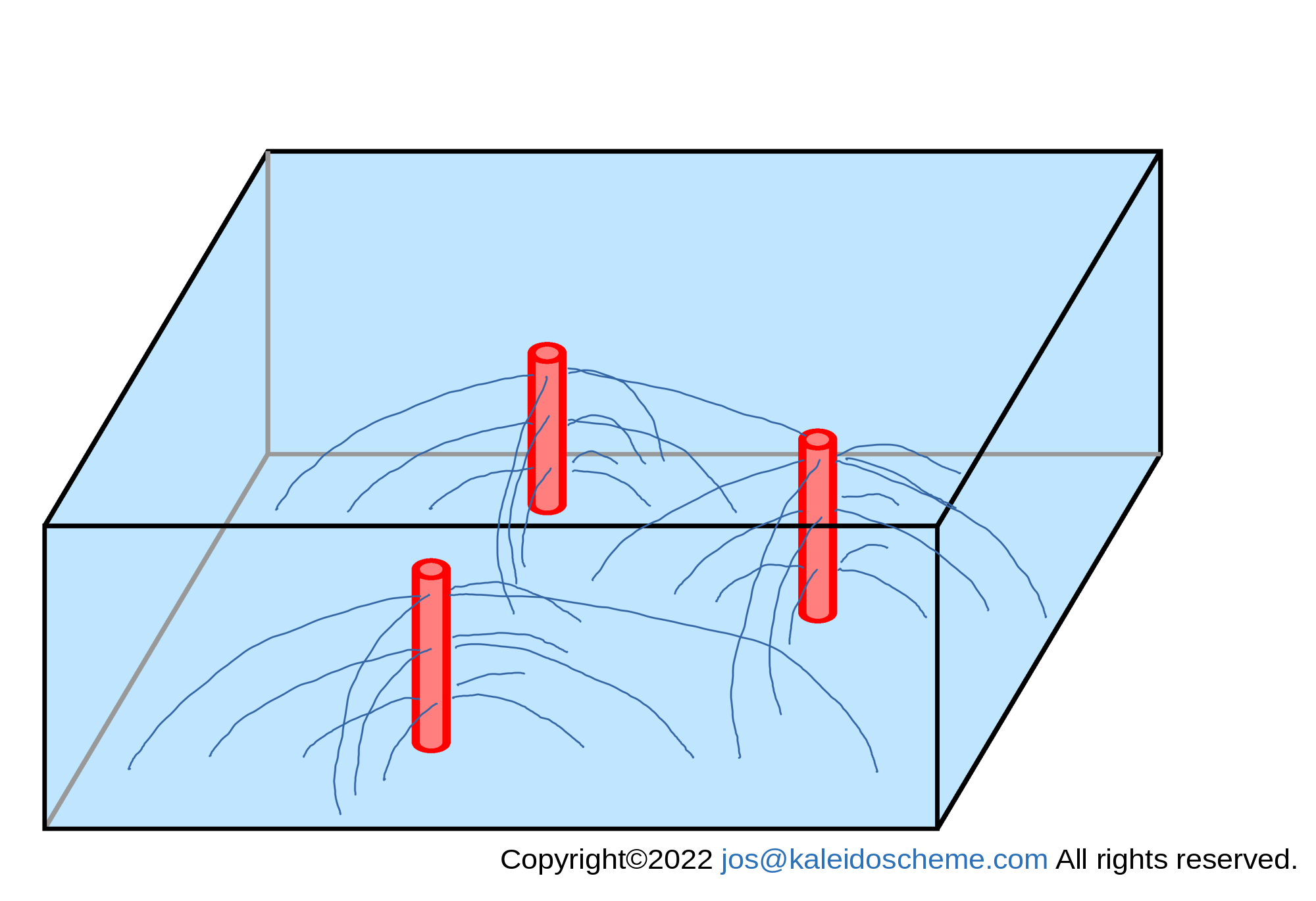
- Many researchers may be uncomfortable with RDC, wondering if our RDC scheme is correct. Don't worry, RDC has been proven to work in equilibrium atmospheres. How can RDC not work at slightly shorter time intervals? Just take a look at https://www.rdctheory.cloud
-
Authoritarians may have a different kind of uneasiness about us, a tiny institute.
Don't worry.
RDC explains "the constant relative humidity assumption"
used in the innovative convective adjustment model in the landmark climate study
that won your most favorite Nobel Prize!😉
- You can guess how the RDC function of constant relative humidity responds to warming. As the amount of saturated water vapor increases steeply with temperature, the amount of water vapor in the atmosphere will increase rapidly and warming will accelerate. DD cannot express this.
-
The CONSTANT Relative Humidity of RDC is due to
- Outflow occurs at all altitudes. (vertically CONSTANT RH)
- It is solved as a boundary value problem in a horizontal region. (horizontally mean CONSTANT RH)
- The vertical structure is the same for different warming conditions when viewed with optical depth. (CONSTANT RH under warming)
-
People believe that the atmosphere does not move unless it is forced to move,
such as by buoyancy.
This is DD's way of thinking.
However, the atmosphere moves to avoid being forced.
This is RDC, where buoyancy acts as a strong constraint.
https://www.rdctheory.cloud/current/RDCParam.html#rdcparam -
Do dynamics people think about how forces work in the atmosphere?
Forces work until they stop working.
So the ultimate way to think about how the atmosphere actually moves is
to study the state in which the forces are not working.
That is RDC.
https://www.rdctheory.cloud - Traditional meteorology has the same idea. For example, when the pressure-gradient force and the Coriolis force are balanced to give no net forcing, a geostrophic wind is realized. As geostrophic winds are the foundation of meteorology, RDC is the foundation of climatology.
-
In the case of RDC, however, we must consider two balancings:
- The subsidence velocity is determined to compensate for radiative cooling.
- A mass-convergent horizontal flow field is determined to compensate for the mass divergence of the subsidence flow field.
-
You can see that the RDC equation consists of two equations.
The whole equation is for atmospheric continuity.
In the square brackets on the right is the vertical mass flux,
whose adiabatic heating compensates for radiative cooling to give a heat balance.
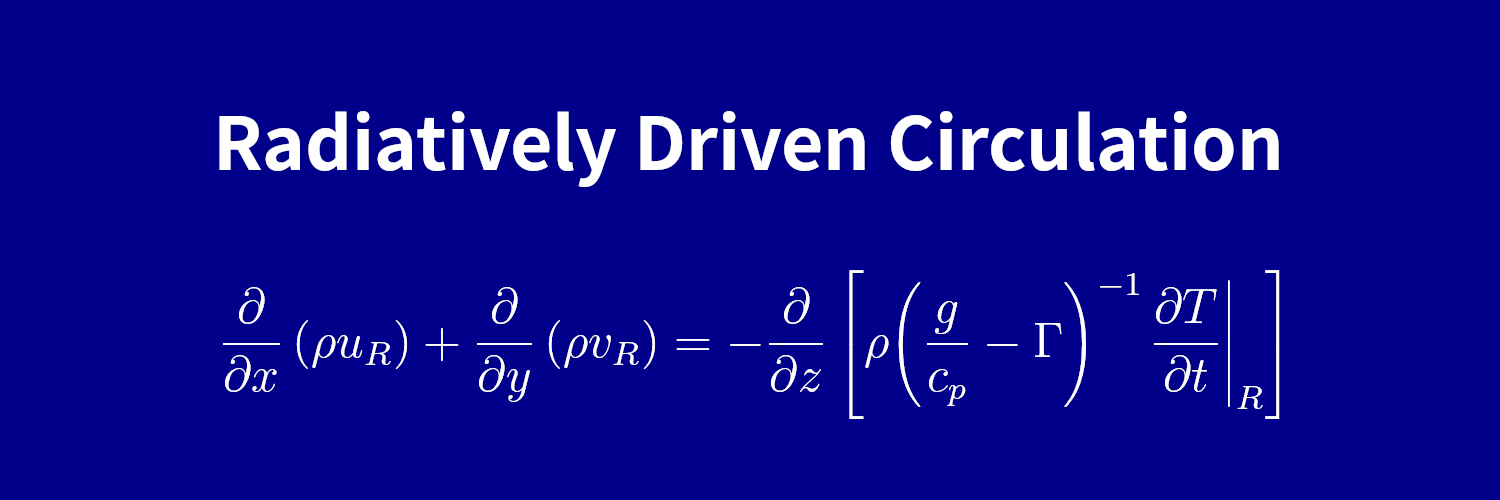
- The mean components of the atmosphere must necessarily obey this RDC equation. Otherwise, the thermal and mass equilibrium of the atmosphere will be destroyed.
- On the other hand, as long as the mean components of the atmosphere obey the RDC equation, mass/heat/water vapor transport out of the cumulus domain will be efficiently performed. NO ADDITIONAL DYNAMICAL DETRAINMENT IS REQUIRED.
- DD that does not coincide with the RDC should never be introduced because it destroys the thermal and mass equilibrium of the mean atmosphere.
-
But how can we make a DD that matches the RDC
if the DD is based only on the dynamics of the cumulus?
To match the RDC,
we need to know the radiative/thermal properties
of the broad subsidence atmospheric field outside the cumulus.
Such a DD is impossible.
https://www.rdctheory.cloud
-
The diagrams explain how the RDC provides a more humid atmosphere compared to the DD/CCC,
and how the relative humidity does not change with warming.
https://www.rdctheory.cloud
Detailed explanations will follow in our replies below.
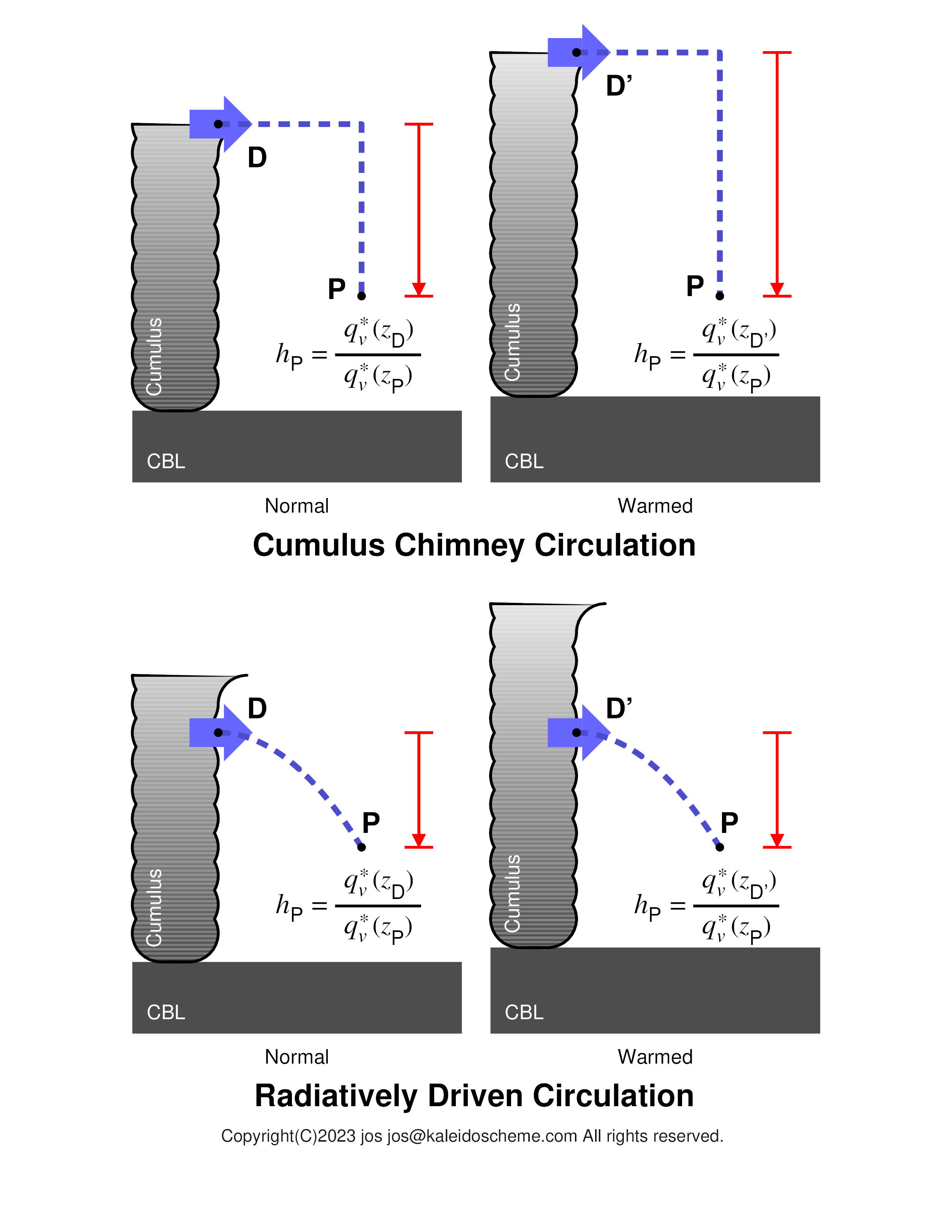
[NOTE]
To show that relative humidity does not change with warming, we have shown a similar figure in our paper, Fig. 11. However, as shown here, it is easier to understand if the point P in the atmosphere for which the relative humidity is considered is fixed.[NOTE]
In the figures on the right for the warmed condition, the relative humidity at point P should be noted as h'P instead of hP. Sorry about that. - In general, the relative humidity hP at a point P of interest at height zP is given by the ratio of the saturated mixing ratio qv*(zD) at the detrainment point D at height zD of the air parcel reaching P to the saturated mixing ratio qv*(zP) at point P.
-
TOP LEFT:
In DD/CCC, the air parcel detrains at altitude zD near the cloud top because it loses buoyancy there. The detrained air parcel reaches point P via such a large drop from zD to zP, that the relative humidity hP at point P is small. Thus, the atmosphere becomes dry. -
BOTTOM LEFT:
In RDC, the air parcel reaching P detrains through the cumulus flank at low altitude zD. Therefore, the relative humidity hP at P, the ratio of the saturated mixing ratio qv*(zD) at D to that qv*(zP) at P, does not decrease. It provides a humid atmosphere. -
COMPARISON between the LEFT figures:
Even under normal conditions, DD/CCC provides a very dry atmosphere, which is one of the problems with the current cumulus parameterization. OTOH, RDC provides a much more humid atmosphere. -
TOP RIGHT (1):
When warming occurs, in DD/CCC, the cloud top altitude increases, which also increases the detrainment altitude D' of the air parcel reaching P, resulting in even lower relative humidity at P. The atmosphere is predicted to dry out. -
TOP RIGHT (2):
During warming, in DD/CCC, air with a lower saturated mixing ratio, determined by higher cloud top altitudes, fills the atmosphere, resulting in a decrease in the amount of water vapor, a greenhouse gas. This implies a NEGATIVE water vapor feedback on warming. -
BOTTOM RIGHT (1):
When warming occurs, RDC does not significantly change the detrainment altitude D' of the air parcel reaching P from the normal altitude D. This means that the relative humidity h'P at P remains almost the same as hP. -
BOTTOM RIGHT (2):
During warming, an increase in temperature, the conservation of relative humidity means that the water vapor mixing ratio will increase at an accelerated rate, i.e., the water vapor distribution in RDC will have a strong POSITIVE feedback on warming. -
COMPARISON between the RIGHT figures:
Thus, the RDC scheme solves the atmospheric desiccation problem that occurs in DD/CCC. Accelerated warming in the real atmosphere can be interpreted as being caused by the strong positive water vapor feedback that RDC provides. DD/CCC cannot predict this. -
We have already published our analysis method and cumulus parameterization
using the RDC scheme.
https://www.rdctheory.cloud
Now we just need to find a collaborator who can implement and realize it.
https://www.kaleidoscheme.com
We look forward to hearing from you.
-
When we started to study the transport around cumulus cloud,
we also had no doubt that only the dynamic flow associated with cumulus cloud
should be analyzed.
Interestingly, such dynamic flow has nothing to do with the outflow.
We were excited to find it.
https://www.rdctheory.cloud/current/how2giveup.html - This is not surprising, however, when we think about it afterwards. According to the 2nd law of thermodynamics, the outflow from a cumulus cloud with a large time-space scale cannot be determined by turbulence mixing in a cumulus cloud with a small scale.
- That was over 20 years ago. We presented it at conferences. But we did not get the response we hoped for. People could not remove their intuitive trust in dynamical flow. RDC was disregarded. Unfortunately the situation is the same today as you see.
- Our mistake was to present only theory and simple model results. If we could demonstrate the effectiveness of RDC with a 3D atmospheric model that people could intuitively accept, we would be able to convert them. And we are now trying to do it with you.
- If the effective RDC transport is demonstrated in 3D atmospheric models, people will no longer be able to ignore RDC. A strong positive water vapor feedback should result, and the accelerated warming of the real atmosphere will be explained by the models.
- This is quite different from the current use of models in climate studies, which simply track real atmosphere changes by adjusting parameters. Computations will move from parameter tuning to predictions based on basic theory, models will evolve from simulators to true predictors.
-
Please return to the basics of fluid mechanics.
Small-scale mixing turbulent flows cannot be integrated into large-scale flows.
That goes against the second law of thermodynamics.
Are you serious about the DD method?
https://www.rdctheory.cloud/current/mug.html -
Cumulus convection is nothing more than vertical mixing of air
to resolve convective instability.
The mixing averages the air uniformly
and never creates a large non-uniform flow like DD.
The RDC mechanism quite different from dynamics creates the flow.
https://www.rdctheory.cloud/current/RDCParam.html#rdcparam -
We should start from the true basis of fluid mechanics and thermodynamics.
It is very dangerous to start from the "basics of meteorology"
which is already structured for weather phenomena based on convention and intuition.
We are talking about climatology.
https://www.rdctheory.cloud/current/RDCParam.html#rdcparam
Look at the stars in the sky. Are they moving? No, we are moving. Is air being blown out of the cumulus clouds? No, the surrounding atmosphere is sucking air out of the cumulus clouds. Apart from the nonlinearity, they are identical in terms of the reversal of perspective.
#RDC
Continuing to approach cumulus detrainment flow from the dynamics of cumulus convection shows that you are unconscious to the nonlinearity of air motion and to the structure of thermodynamics and continuity outside the cumulus.
https://www.rdctheory.cloud/
-
If the air were a linear medium,
the dynamical causes of cumulus detrainment flow might be justified.
However, because it is a nonlinear medium,
motions that resolve convective instability will never produce significant flow,
but only mixing.
Fundamental.
https://www.rdctheory.cloud/current/mug.html -
Meteorological methods are useful for phenomena
for which their validity has been established.
However, when applied to unsolved phenomena,
fundamental considerations must be made to ensure that they are physically feasible.
https://www.rdctheory.cloud/current/whatIsWrong.html -
Meteorological phenomena are so familiar that we have come to believe
that we can understand them all intuitively.
However, the nonlinearity of cumulus convection is a good example
of how our intuition can lead to very different results.
Consider RDC!
https://www.rdctheory.cloud/current/RDCParam.html#rdcparam -
When the small-scale turbulence associated with mixing in a cumulus cloud
is integrated into a meaningful outflow,
it is a violation of the second law of thermodynamics.
Or, you say only the atmosphere is an exception that breaks the fundamental principle?
https://www.rdctheory.cloud/
-
The idea that forced flow from a small outflow source creates a large field flow
is a linear theory of flow and is rejected in modern fluid mechanics.
Air is a nonlinear medium,
and large flows should be governed by mechanisms appropriate to their scale.
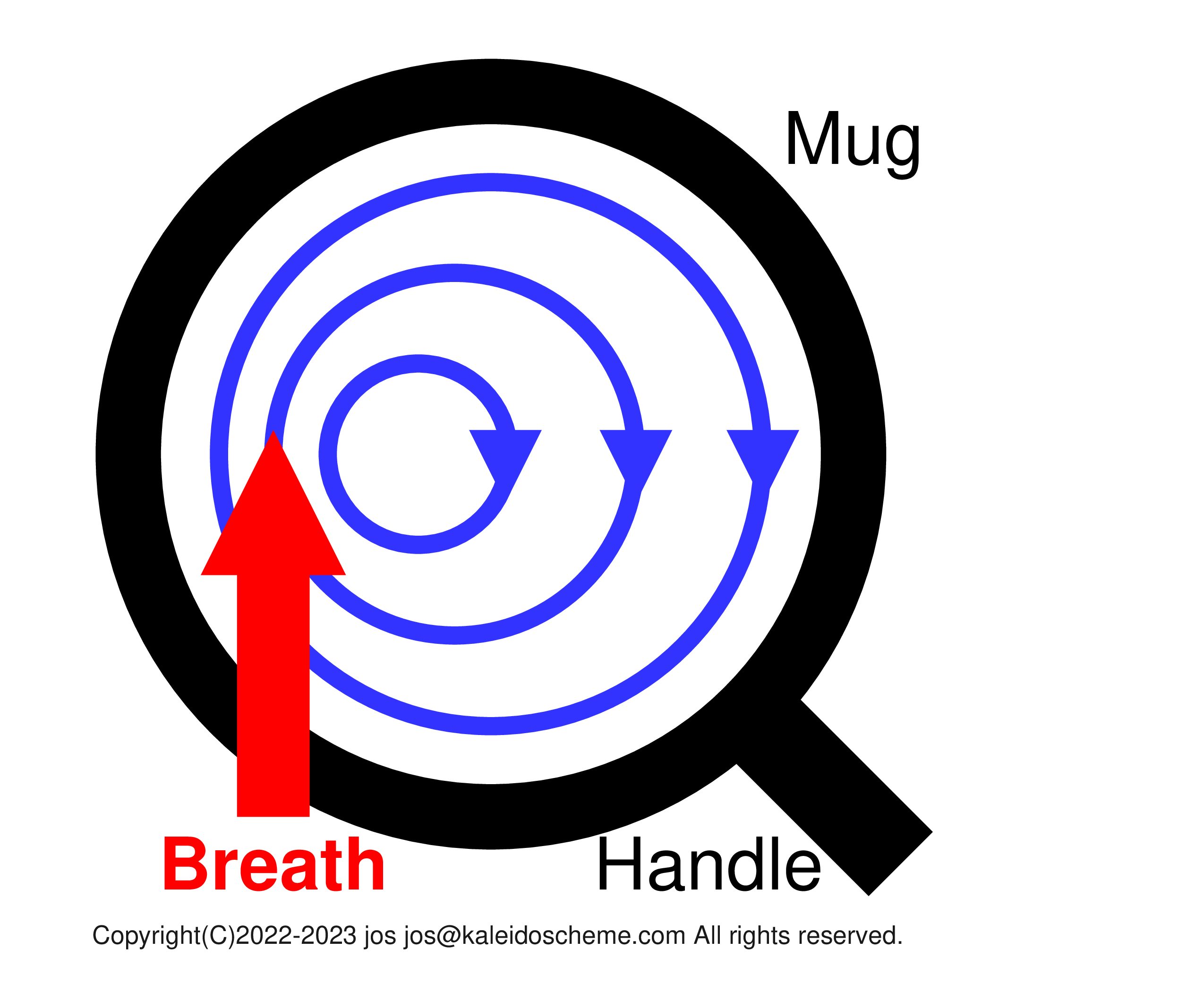
- Traditional meteorology has been able to accurately describe atmospheric phenomena because each theory is based on the dynamical disturbance that has the SAME SCALE as the phenomenon, i.e., the synoptic scale, the meso scale, and the cumulus scale.
- In this sense, the cumulus detrainment flow deviates from the traditional meteorological framework. Although its source is a small cumulus cloud, the flow extends over a large clear area around it.
-
It is a mistake to look for the mechanism of the cumulus detrainment flow
in the dynamics within a small cumulus cloud.
This is Dynamical Detrainment.
The mechanism should be found in the structure of a large clear sky area.
That is RDC.
https://www.rdctheory.cloud/current/RDCParam.html#rdcparam -
RDC is a climatological, not a meteorological phenomenon,
both in its mechanism and in its water vapor feedback effect on global warming.
You need to change your thinking.
https://www.rdctheory.cloud/
- Even if thermal and mass balance in an atmospheric model is calculated, RDC will not be treated correctly if the balance is due to dynamical forcing; the very nature of RDC is "Radiatively Driven" and the RDC mean flow component must be treated separately from the dynamics.
- Existing atmospheric models for weather forecasting can reproduce meteorological phenomena without considering RDC. However, models for climate prediction, where the radiation budget becomes important, will give very different results if the RDC is not treated separately.
-
The reason is that the mass divergence in Radiatively Driven subsidence flow,
with small absolute values, must be treated separately,
or they will be omitted as errors in the large motion caused by the dynamics.
https://www.rdctheory.cloud/current/RDCParam.html#rdcparam -
This mass divergence may be small for the local values treated in the dynamics,
but it occurs over a large clear area,
resulting in a sufficiently strong flow around the cumulus cloud
as a consequence of the RDC boundary value problem.
https://www.rdctheory.cloud/current/RDCParam.html#rdcparam
-
We wrote this page half in jest, because it is obvious.
However, contrary to our expectations,
researchers may REALLY not understand the nonlinearity of air motion.
Detrainment flow study by those who do not know the nonlinearity of air flow
is a tragedy.
https://www.rdctheory.cloud/current/mug.html - If you are not familiar with the nonlinearity of air motion, we strongly recommend that you learn about it and the second law of thermodynamics; the energy spectrum transitions from phenomena with long wavelengths and time durations to those with shorter ones. Never the opposite.
-
In this sense, ALL DD methods are wrong.
When they claim to correctly reproduce a phenomenon,
another artificial and erroneous process compensates for it.
Such a system is not natural and cannot predict the future state.
Please consider RDC.
https://www.rdctheory.cloud/ - The process of upward mass flux supplied from the cloud base flowing out of the cumulus cloud at each height DYNAMICALLY cannot be realized without assuming laminar flow. In real air, however, such a flow that resolves convective instability is immediately converted into useless turbulence.
- This means that cumulus convection does nothing but vertical mixing, and horizontal transport is, contrary to our intuition, extremely inefficient. Horizontal transport out of the cumulus is performed by the RDC based on the structure of the atmosphere outside the cumulus.
-
In fluid mechanics, especially for phenomena that span multiple scales,
nonlinearity is of paramount importance.
To discuss the flow around cumulus,
which spans the different scales of cumulus and clear sky,
without considering it is to miss the point.
https://www.rdctheory.cloud/current/mug.html - Traditional meteorology has developed without awareness of strong nonlinearities, because problems have been classified into synoptic/meso/cumulus scales. However, climatology, which must consider water vapor feedback, must take into account transport between different scales.
- In fact, the nonlinearity of flow is so difficult to deal with that it has only recently received a little mention in the curriculum. However, just because we have not learned about it in textbooks does not mean that we can look at the phenomena with the wrong linear theory.
- Conventional meteorology has many problems for discussing climatology, such as radiative processes without awareness of radiative equilibrium and forced flow without awareness of nonlinearity. Cumulus detrainment flow needs to be discussed by going back to the basics of physics.
-
Whoever does that will reach the RDC scheme.
https://www.rdctheory.cloud/current/RDCParam.html#rdcparam -
The DD method diverges into many variants and implementations,
unlike the RDC scheme of a convergent study mentioned above.
This shows that there is a methodology but not a principle in the DD method.
https://www.rdctheory.cloud/current/methodology.html
-
Only meteorologists believe in Dynamical Detrainment.
Ask physicists in other fields.
They will laugh at the idea of mixed turbulence in a small cumulus
producing a large outflow.
Convection is just mixing. Without the RDC mechanism,
there is no significant outflow.
https://www.rdctheory.cloud/current/whatIsWrong.html -
There is a reason why they cling to dynamics.
It is because almost everything in weather forecasting
has been solved as a dynamical problem.
But to study climatology,
they have to open their eyes to physical processes other than dynamics.
That's RDC.
https://www.rdctheory.cloud/current/psychology.html -
RDC is kinematics without forcing.
In this sense, it is a new concept,
completely different from traditional meteorological dynamics.
RDC is an important piece of the puzzle
that fills a void in atmospheric physics in the study of climatology.
https://www.rdctheory.cloud/current/RDCParam.html#rdcparam
-
We have always maintained that the DD method violates The 2nd Law Of Thermodynamics.
But you don't seem to realize this,
so we will explain it using the transitions of the kinetic energy spectrum,
which can be clearly visualized.
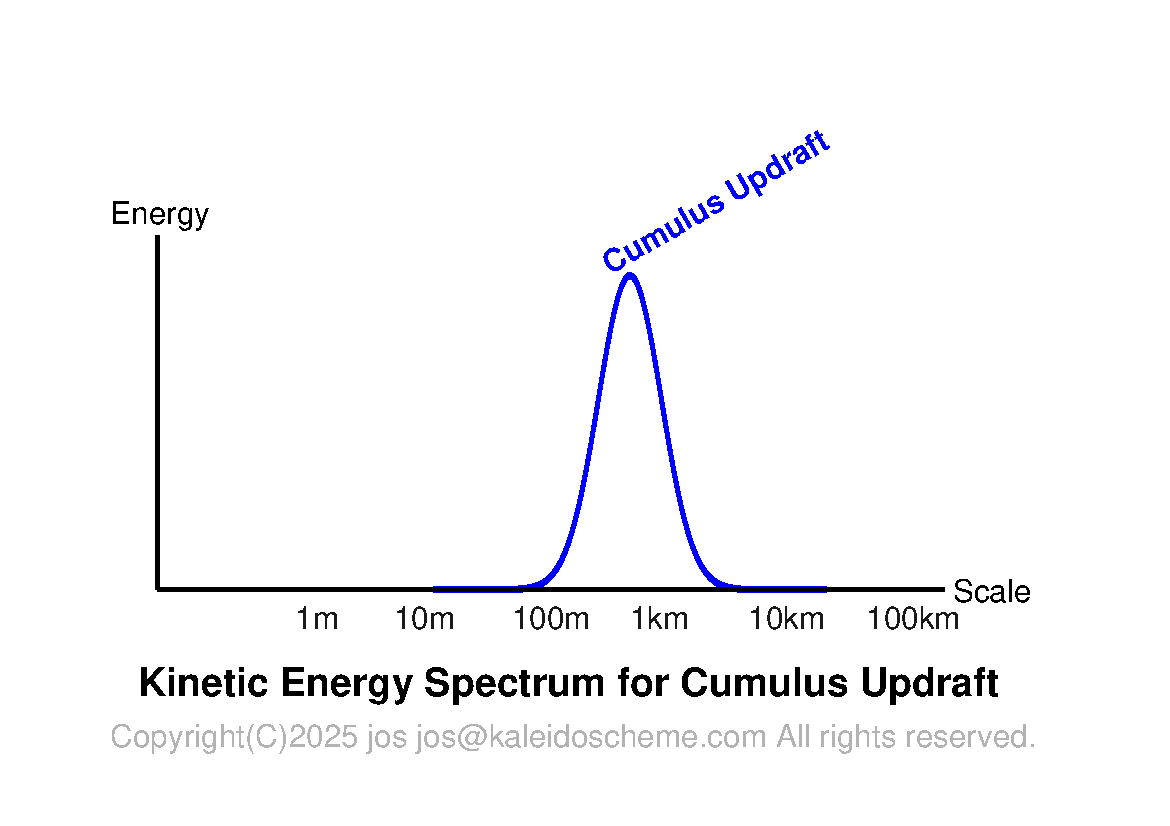
- The figure above shows the kinetic energy spectrum for the spatial scale of a moist thermal plume in an early stage of cumulus development. The peak is located at about 1 km, which is a typical radius for a cumulus cloud. Let's look at its temporal transitions.
-
This shows the time transition of the kinetic energy spectrum
of the cumulus cloud in nature.
A flow on a larger spatial scale will always transition
to a flow on a smaller spatial scale.
Transitions in the opposite direction never occur.
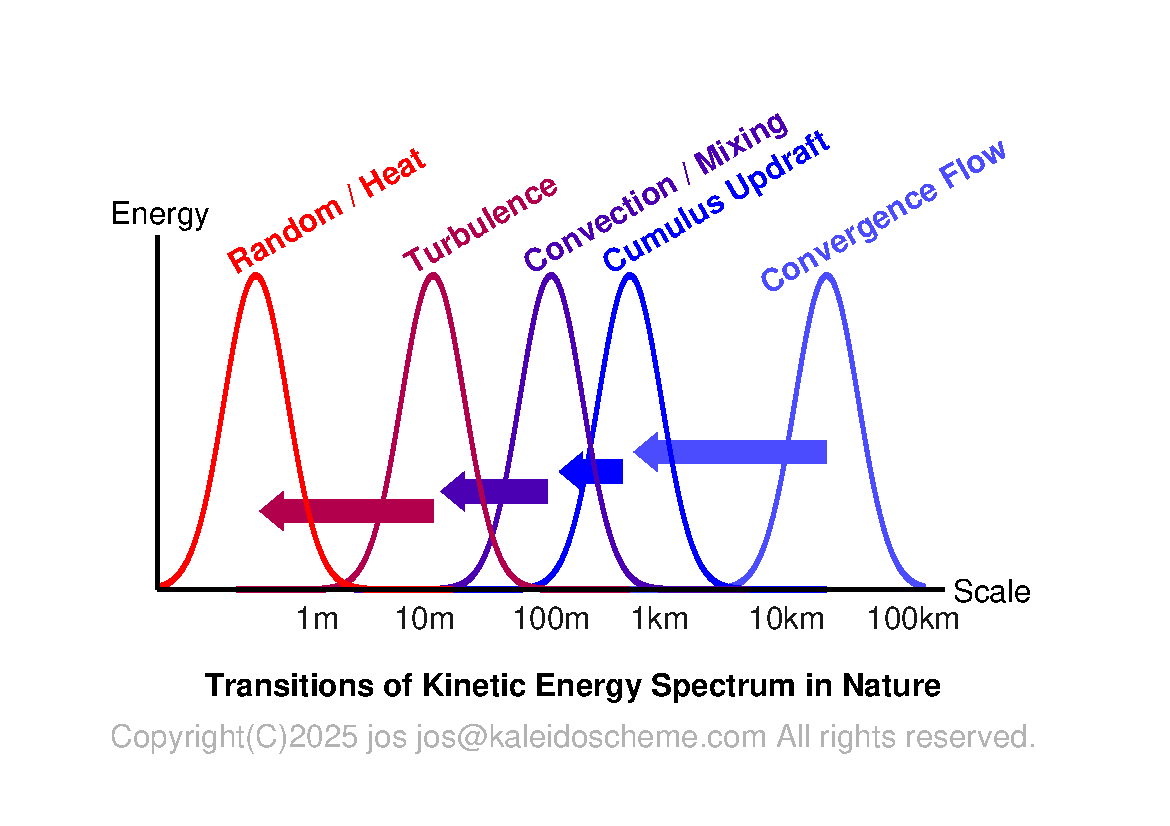
- Here, we have assumed a solitary cumulus cloud, so the convergence flow is shown as having a large spatial scale. However, even convergence flows at smaller meso-scale always have a spatial scale larger than cumulus clouds.
- Starting from a convergence flow, the cumulus convection flow progressively transitions to smaller flows, eventually reaching heat, which is random molecular motion. The Second Law of Thermodynamics guarantees the direction of this natural transition.
-
The same figure for the case of Dynamical Detrainment.
Somewhere in the stages where the cumulus flow changes to smaller scales,
an inverse transition occurs and a detrainment flow larger than the cumulus is formed.
It is distinctly different from the other transitions.
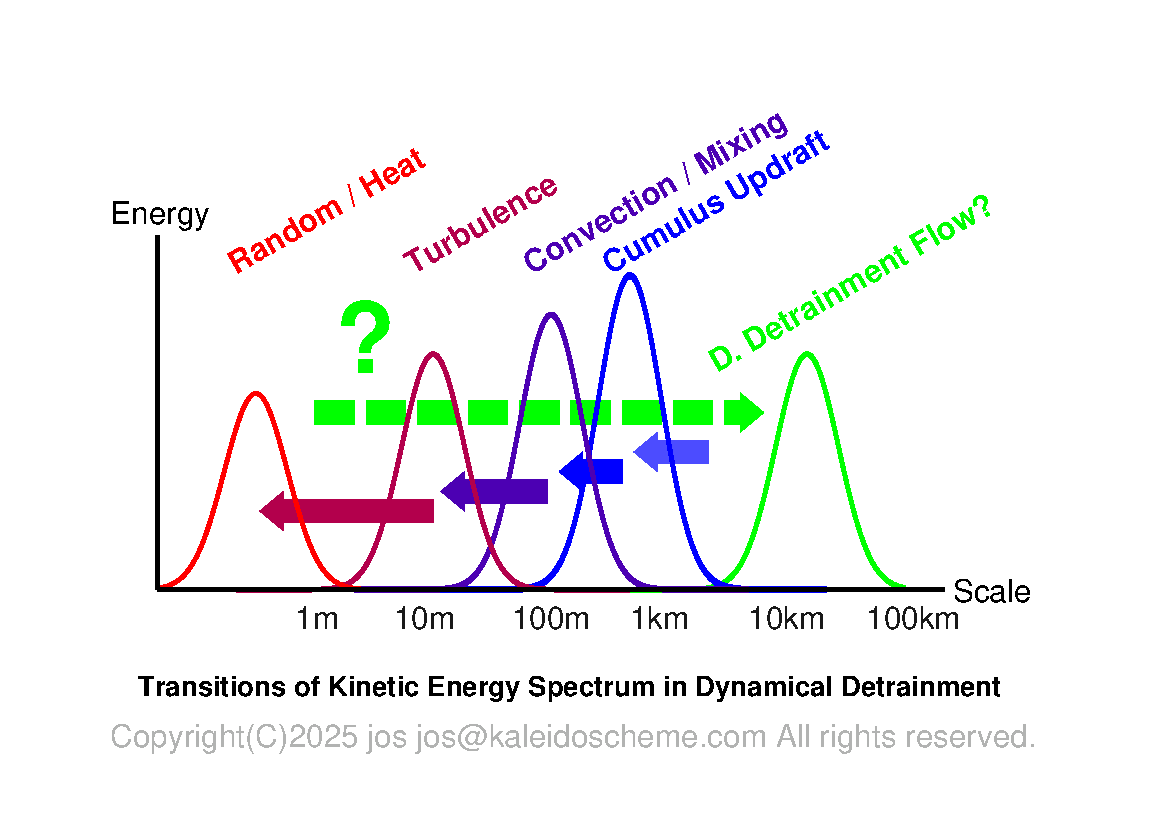
- Such an inverse transition is never allowed by the Second Law of Thermodynamics. With enormous energy and a deliberate structure, engineering might be possible to increase the scale of the flow. In an open atmosphere, however, there is no structure, and latent heat release only enhances mixing.
- This problem arises when trying to consider detrainment flow within a set of dynamics. Cumulus detrainment flow should be considered separately from the dynamics framework.
- If we consider the detrainment flow as an RDC, all of its flow can be treated only in the range of scales larger than the cumulus. This does not violate The 2nd Law Of Thermodynamics. Please examine the RDC scheme.
- We invite you to contact us immediately to begin our RDC scheme collaborations as soon as possible. We look forward to your serious consideration.
- Cumulus convection develops to neutralize atmospheric convective instability by driving the VERTICAL transport of mass, heat, and water vapor. However, convection dynamics offers no physically grounded mechanism for efficient HORIZONTAL transport; that function is provided by RDC.
- How much longer will researchers rely on intuition to explain cumulus detrainment from convective dynamics? If they’re not yet aware of the RDC, that’s one thing. But we’ve laid out the RDC scheme clearly, and we urge them to give it serious consideration.
- Cumulus detrainment isn’t just sidewall outflow. It must deliver the flow to distant points across the broad subsidence region. Dynamically forced blowout inevitably produces turbulence, making it unfeasible. This is because such flows follow the nonlinear equations of motion.
- On the other hand, the RDC scheme can maintain laminar flow over a broad area, because it is based on thermodynamic equilibrium and mass continuity throughout the extensive subsidence region. The flow is solved as a boundary-value problem expressed by the RDC Poisson equation.
- You may recall from math-physics classes that a time-evolution equation with nonlinear terms amplifies the high-frequency components of its solution, while a boundary-value problem yields a solution spread across a broad region. From this, you can see which is the right approach.
- Of course, here “high-frequency components” refers to turbulence, and “a solution spread across a broad region” refers to the laminar RDC flow.
-
This diagram alone clearly shows the physical inconsistency of Dynamical Detrainment.
No matter how one manipulates it at any intermediate stage,
all DD methods inevitably violate the Second Law.
Why aren't you taking action?
Transitions of Kinetic Energy Spectrum (energySpectrum.html)

- We are merely stating the obvious. Phenomena that violate the Second Law of Thermodynamics are impossible. Therefore, the DD method is incorrect. What possible objection could there be to this reasoning? Researchers, return to the fundamentals.
- We feel a strong sense of unease and crisis. Processes that violate the Second Law should be rejected immediately; yet, they persist within the global warming research community. If this most fundamental argument is not persuasive, what kind of discussion is possible?
- We are speaking to you, not to anyone else. Please invite researchers from other fields to a lab meeting to discuss the validity of the DD method. They will undoubtedly make the same points that we have. Discussions confined to the same community are meaningless.
- People believe that air doesn't move without an external force. However, there are situations in which movement is inevitable BECAUSE OF THE ABSENCE of an external force. This motion is Radiatively Driven Circulation (RDC) and occurs in atmospheres undergoing radiative cooling.
- This may be hard for atmospheric dynamics experts to accept. Remember that in their most favorite Geostrophic Wind, which results from the balance between pressure gradient and Coriolis forces, an air parcel does not experience any forcing. In this respect, RDC is similar to GW.
- Within RDC, the balance between net radiative cooling and excess adiabatic heating associated with subsidence motion allows the sinking air parcel to go along the ambient temperature and to maintain a state in which it experiences no buoyancy/forcing.
- Due to steep atmospheric density stratification, the subsidence mass flux, the product of subsidence velocity and density, generally diverges, creating vacuums everywhere. From atmospheric continuity, horizontal mass flux is induced through the cumulus flanks to fill the vacuums.
- Differing in horizontal and vertical components, both Geostrophic Wind and RDC represent mechanisms for achieving equilibrium. Just as GW was considered a fundamental process in meteorology, RDC should be regarded as a fundamental process in climatology.
- Another difference: Geostrophic Wind was about the straightforward balance of forces, while RDC is about the balance of heating/cooling. Therefore, RDC can be described as a "thermodynamic flow circulation", which makes RDC difficult to grasp intuitively.